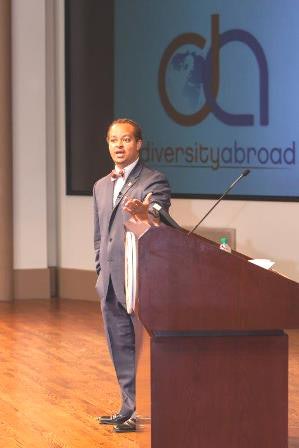 Dr. Aaron I. Bruce, Chief Diversity Officer at San Diego State University, says that, “Culturally responsive international education provides a space for students to contribute to the learning process through the lens of their own identity and cultural realities.”
Dr. Aaron I. Bruce, Chief Diversity Officer at San Diego State University, says that, “Culturally responsive international education provides a space for students to contribute to the learning process through the lens of their own identity and cultural realities.”While it has not been a primary topic of conversation in higher education circles in recent years, the dearth of minorities included in programs to study abroad has not gone undocumented. Now, experts are trying to figure out how to improve the situation.
According to the Institute of International Education (IIE), of all U.S. students that participate in study abroad programs, 76.4% are White as of 2012, compared to Asian American/Native American and Pacific Islander at 7.7%, Hispanic/Latino at 7.6% and African-American participants at 5.3%. IIE Director of Public Affairs Sharon Witherell stated that “the study abroad population is still 76% White students, slightly better over the years, but just not enough diversity.”
Andrew Gordon, founder of Diversity Abroad, says that he believes that access to international education for minorities is limited and that exposing underrepresented students to study abroad experiences makes for a culturally aware and enriched student.
“Traditionally, students from diverse backgrounds have been underrepresented in international education and exchange programs,” said Gordon, whose group connects diverse students, recent graduates and young professionals with international study and intern, teach, volunteer, degree and job opportunities.
“As our world becomes more interconnected, the perspective and skills students gained through international programs will be essential for success,” he said.
Diversity Abroad, which was created in 2006, held its second annual conference last week in San Diego. The goal of the networking and professional development event is to bridge the gap between domestic higher education leaders and academics abroad through sharing practices, initiatives and forum participation to advance diversity and inclusion for study abroad programs.
“The cultural responsiveness of educators is paramount in fostering a rewarding learning process for historically underrepresented students in study abroad,” said keynote speaker Dr. Aaron I. Bruce, Chief Diversity Officer at San Diego State University. “Culturally responsive international education provides a space for students to contribute to the learning process through the lens of their own identity and cultural realities.”
The conference addresses larger issues related to promoting programs on campuses and trains higher education professionals on how to expand study abroad programs to become more inclusive and prepare for challenges diverse students face when entering another country.
“This conference is a unique meeting that brings together international and diversity higher education professionals to collaboratively tackle the barriers to international programs that diverse students face,” Gordon explained.
Keynote speaker Bruce said the experience of studying abroad allows an individual to analyze the commonalities and differences between domestic students and citizens of the world.
“Diversity is important before, during and after studying abroad,” said Bruce. “The re-entry program and the opportunity to deconstruct an experience abroad through the lens of identity is increasingly paramount in high-impact global initiatives.
“Yes, there is the common thread of reverse culture shock. However, the re-entry of many students included the layer of their diverse identity. Universities are beginning to explore ways to assist diverse populations of students in making sense of their experience abroad through the lens of their identities. Existing challenges include helping find a framework for sharing diversity abroad experiences when none of their friends or families have ever left the U.S.”
The group has found that one obstacle to participation is that minority students often are not eager to experience the world outside their comfort zones or discuss their experiences once they return to the U.S. According to Bruce, “Students sometimes internalize trauma or discrimination they encounter abroad, thinking nobody would understand. Trust and credibility will continue to be an important factor in motivating students to go abroad as well as helping them process their travel during and upon their return.”
Upon evaluating existing study abroad programs and launching new ones at colleges and universities, Bruce questions their validity.
“What is the quality of the program as it relates to diversity and inclusion?” Bruce asked. “Furthermore, are our teams truly prepared to address the concerns of demographics that often are viewed as invisible?”
Jamal E. Mazyck can be reached at [email protected] and on Twitter @jmbeyond7.


















